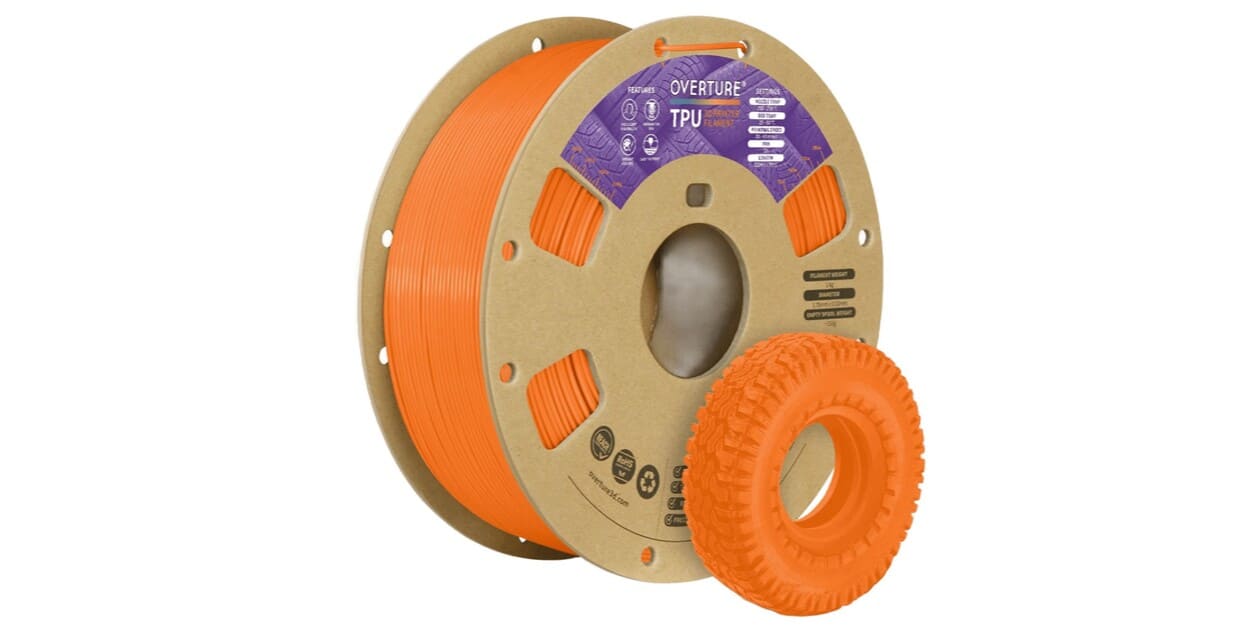Banner Image Courtesy of Overture 3D
What Is Flexible Filament?
Flexible filament refers to thermoplastic materials formulated to remain soft and elastic after extrusion. Unlike rigid filaments such as PLA or ABS, flexible filaments return to shape after deformation and can absorb impacts, conform to surfaces, or provide cushioning. They’re commonly used in FDM/FFF printers and are rated by Shore hardness (a measure of softness — lower = softer) and elongation (how far they stretch before breaking).
Common flexible filament brands and formulations vary, but most fall into a few families — TPU, TPE, and TPC — each with distinct characteristics and printing behaviors. Choosing the right one depends on the applications, the printer, and post-processing needs.
TPU Filament and Its Key Material Properties
TPU (Thermoplastic Polyurethane) is the most popular flexible filament. It balances elasticity, toughness, and abrasion resistance, making it a go-to for durable, rubber-like prints.
Key properties:
• Shore hardness: Common grades are Shore 60A to 95A. Lower numbers (60–70A) feel soft and rubbery; higher numbers (85–95A) are firmer.
• Elongation at break: Very high — often 200%–700% — so parts stretch a lot before failing.
• Tensile strength & toughness: Good tear resistance and fatigue life for repeated flexing.
• Abrasion & chemical resistance: Excellent for wear parts and grips.
• Printability: Moderately easy on direct-drive extruders; requires slower print speeds, careful retraction settings, and often a larger nozzle/better filament path to avoid kinking.
TPE Filament and Its Key Material Properties
TPE (Thermoplastic Elastomer) is a broader category of flexible materials that behave like rubber but process like plastics. In filament form, TPE-type blends (sometimes labeled as “TPE” generically) provide softer, more elastic results than many TPUs.
Key properties:
• Shore hardness: Typically available in very soft grades (Shore 35A–75A), making them closer to a silicone-like feel.
• Elongation: High — good elasticity for soft-touch items.
• Compression set: Often slightly higher than TPU, which means a TPE part may not rebound as perfectly after long compression periods.
• Printability: Generally trickier than TPU — more prone to stringing and oozing. Benefit from direct-drive extruders and fine-tuned retraction and speed settings.
• Feel & tactile quality: Superior “soft touch,” ideal when user comfort is primary.
TPC Filament and Its Key Material Properties
TPC (Thermoplastic Copolyester or Thermoplastic Polyester Elastomer) occupies a middle ground: more engineering-focused than TPE and sometimes more heat/chemical resistant than TPU.
Key properties:
• Shore hardness: Often in the mid-range (Shore 70A–85A), offering a balance of flexibility and structural integrity.
• Heat resistance: Better thermal stability than many TPUs/TPEs — useful where parts see higher temperatures.
• Chemical resistance & fatigue life: Strong performance, making TPC attractive for industrial or automotive components.
• Printability: Generally printable on a wide range of printers, but benefits from a stable filament path and controlled speed. Warping is typically low.
• Use case focus: Engineering-flexible parts that need durability under load, heat, or exposure to oils/chemicals.
Pros and Cons of 3D Printing Flexible Filament
|
Pros |
Cons |
|
Elasticity and impact resistance, parts absorb shocks and recover. |
Harder to print, requires slower speeds and tuned extrusion. |
|
Soft-touch surfaces, great for wearables and grips. |
Lower dimensional accuracy, softer materials can compress. |
|
Enables one-piece designs (living hinges, snap fits). |
Limited post-processing, sanding/painting/gluing are more difficult. |
|
Custom-fit parts (gaskets, insoles) for tailored fits. |
More stringing and oozing, needs careful temperature/retraction tuning. |
|
Vibration isolation and damping applications. |
Lower load-bearing capacity in very soft grades. |
|
Wide range of hardness options across TPU/TPE/TPC. |
Feeding issues on Bowden setups, direct-drive preferred. |
|
Good abrasion and chemical resistance (esp. TPU/TPC). |
Typically longer print times due to slower, careful profiles. |
|
Enables soft, ergonomic, and wearable designs not possible with rigid plastics. |
Adhesion to rigid mating parts can be challenging without design allowances. |
Top Applications
Wearables & lifestyle: Phone cases, watch bands, shoe insoles, fitness accessories.
Seals & gaskets: Custom-fit seals for prototypes or low-volume production.
Soft robotics & hinges: Flexible joints, bellows, and compliant mechanisms.
Vibration isolation: Dampers and mounts that reduce noise and shock.
Medical & prosthetics (non-implantable): Orthotic supports, grips, and assistive devices.
Automotive & industrial: Flexible couplings, cable glands, and resistant connectors using TPC-grade materials.
Try Hi3DP FDM 3D Printing Service
Looking to skip the calibration and dial-in work?
Here’s why thousands of customers trust Hi3DP:
Instant Quotes & Rapid Turnaround: Upload your STL, choose PETG, and get pricing within minutes—shipped in as little as 2 business days.
Quality Assurance: Parts undergo dimensional inspection and strength testing to meet your specifications.
Custom Finishes & Assembly: Post-processing options include sanding, painting, and chemical smoothing. Assembly and kitting services are available for multi-part projects.
Global Shipping & Support: Whether you’re in North America, Europe, or Asia, we deliver reliable quality worldwide.
FAQs
Q: Can I print flexible filament on any FDM printer?
A: Most hobby printers can print flexible filament, but direct-drive extruders handle it best. Bowden setups can work with stiffer flexible grades but require slower speeds and careful filament path management.
Q: What’s the easiest flexible filament to print?
A: Mid-firm TPU (Shore 85A–95A) is typically the easiest — flexible enough for many uses but firm enough to feed reliably.
Q: How do I reduce stringing with TPU/TPE?
A: Lower print temperature slightly, slow down travel speed, tune retraction (shorter, slower retractions), and enable coasting or combing if your slicer supports it.
Q: Should flexible parts be designed differently?
A: Yes. Use fillets, avoid thin unsupported pillars, and design living hinges with proper thickness. Plan for lower dimensional stiffness and allow extra clearance for mating parts.
Q: Can I glue or paint flexible prints?
A: Adhesion can be challenging. Use flexible adhesives (silicone-based or urethane adhesives) and flexible-compatible paints if needed. Surface prep (light sanding, primer) helps.














